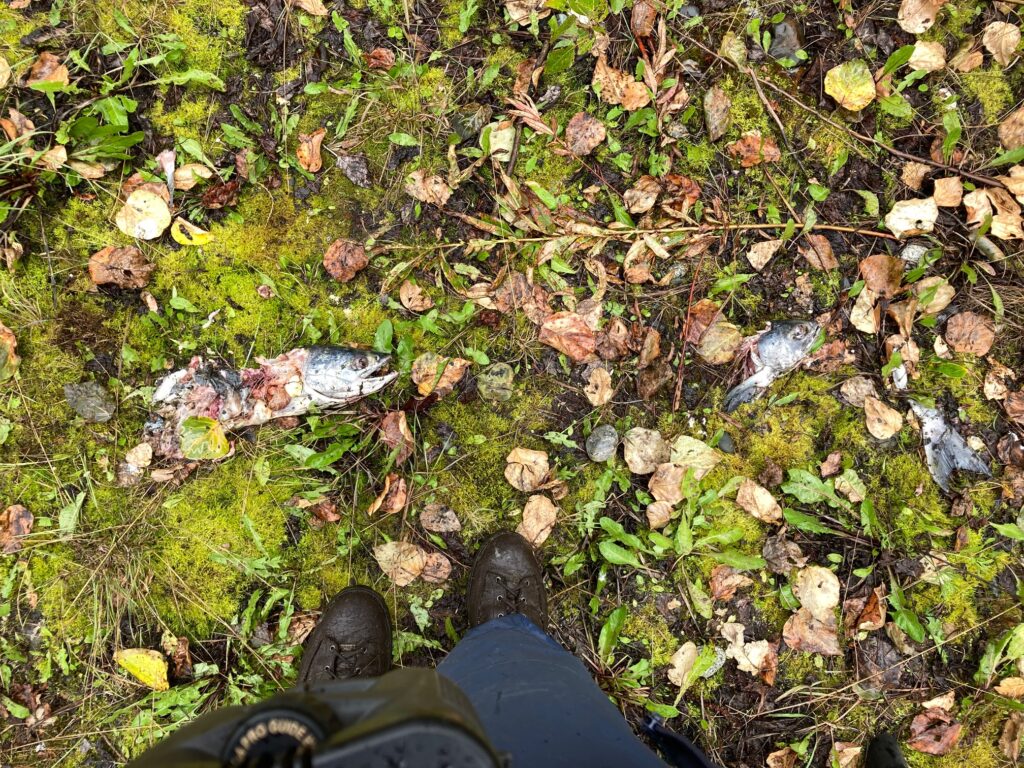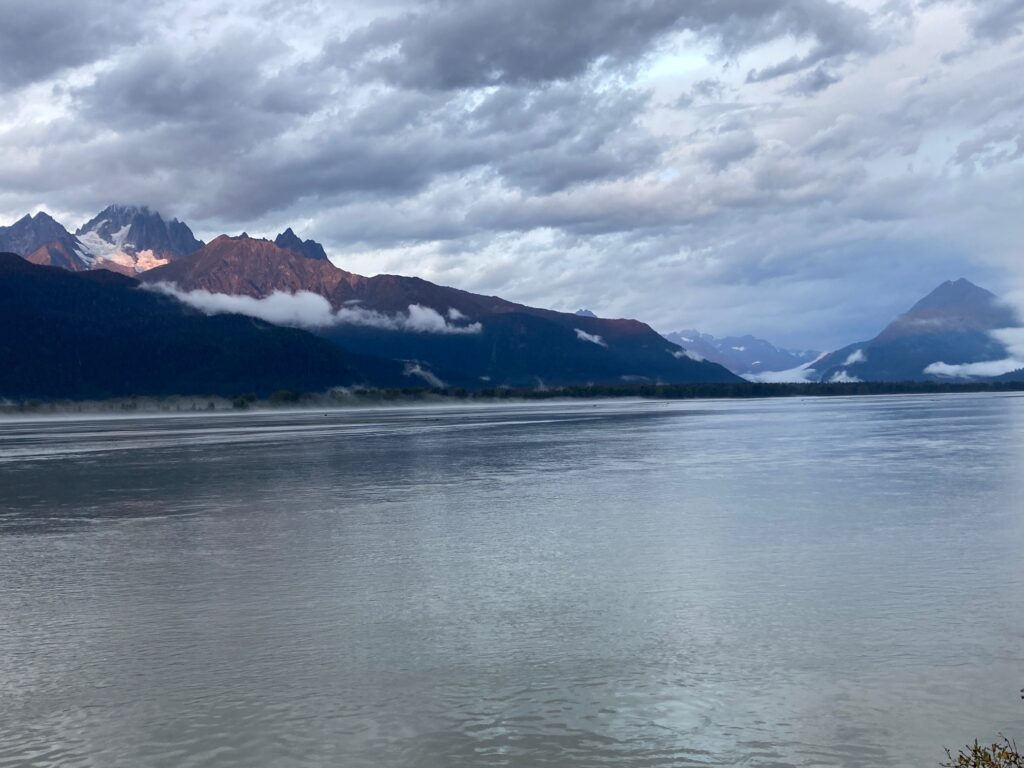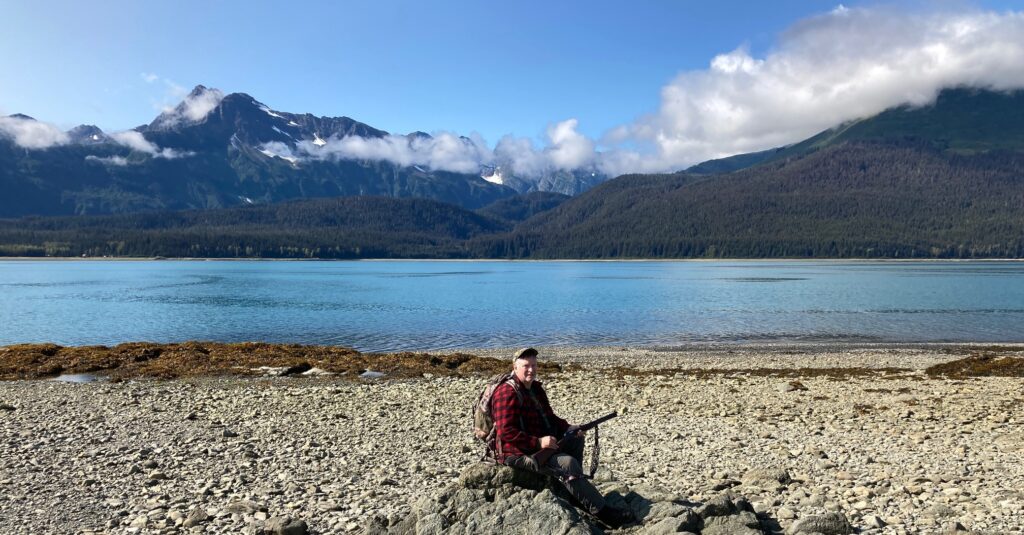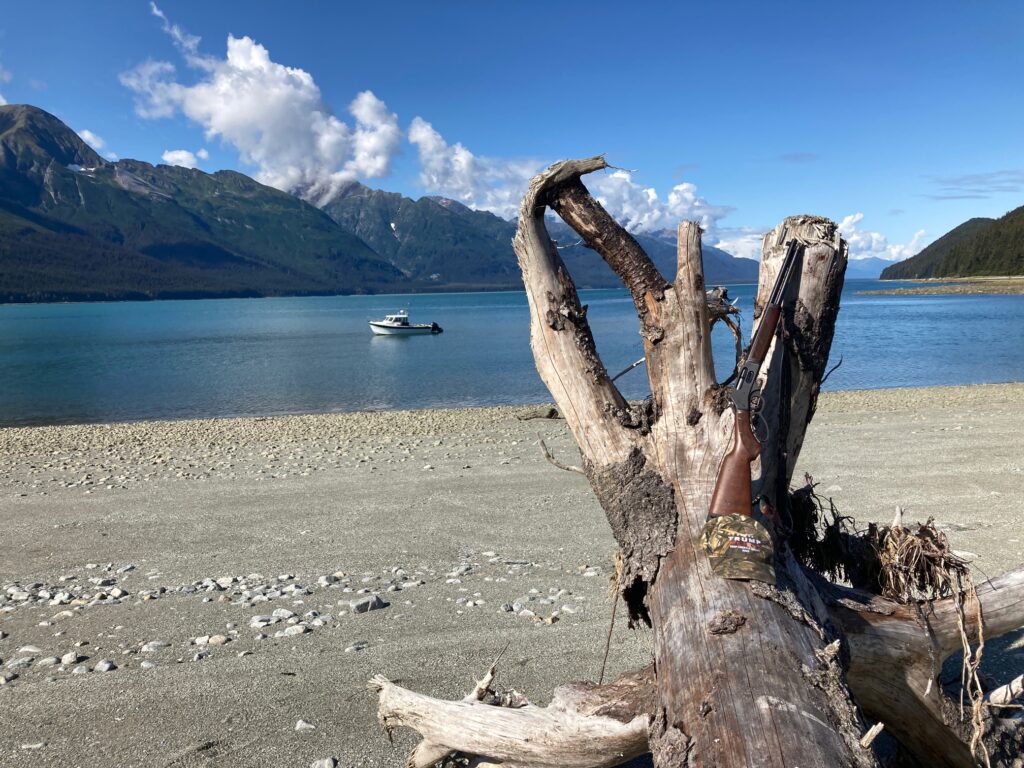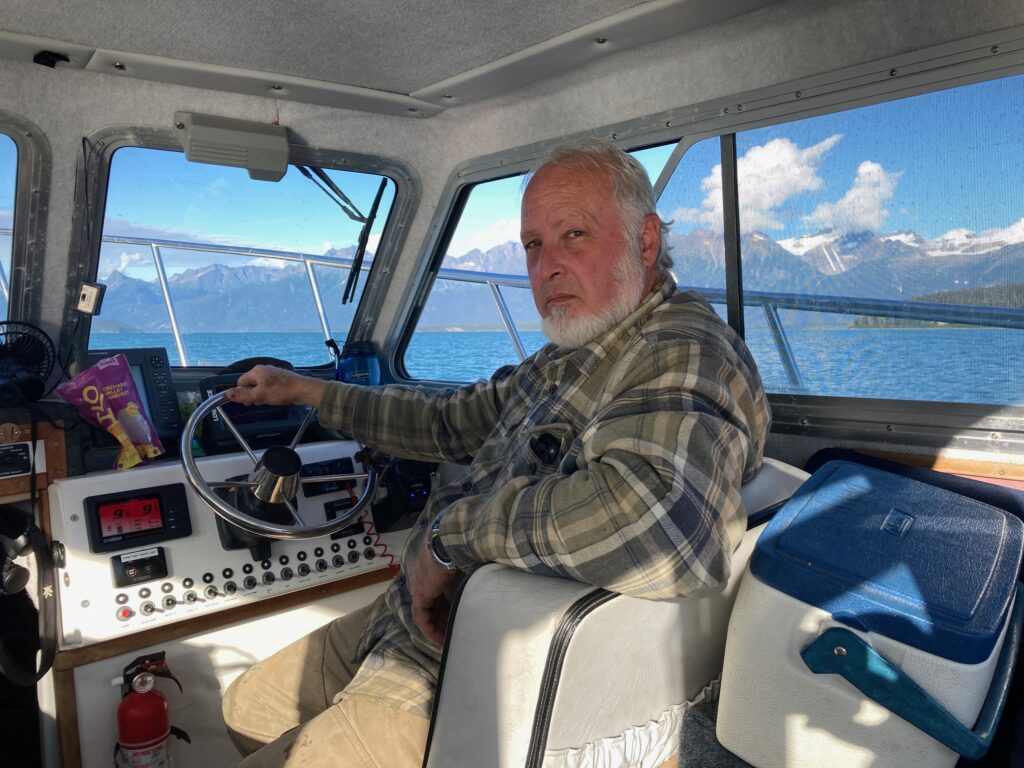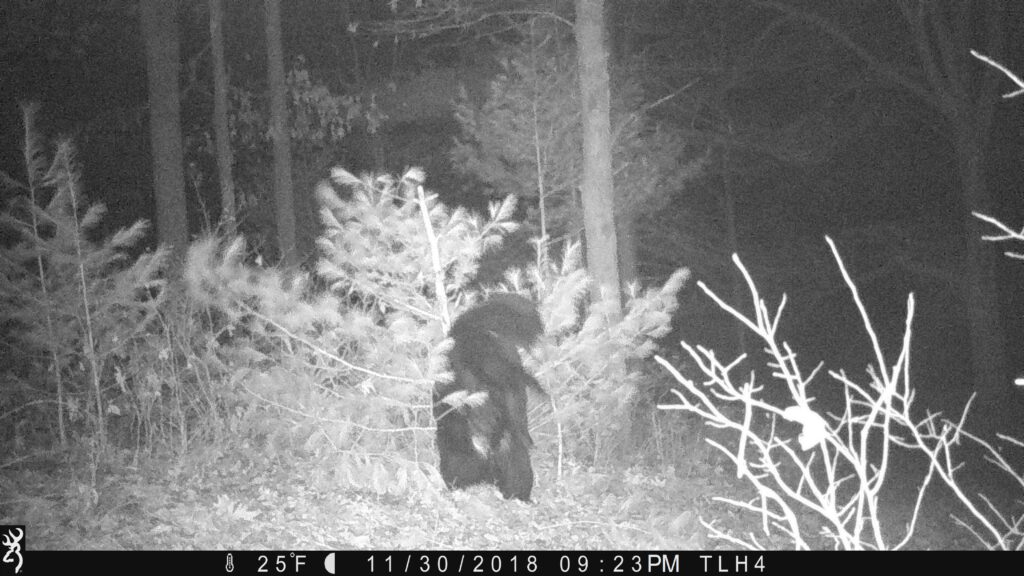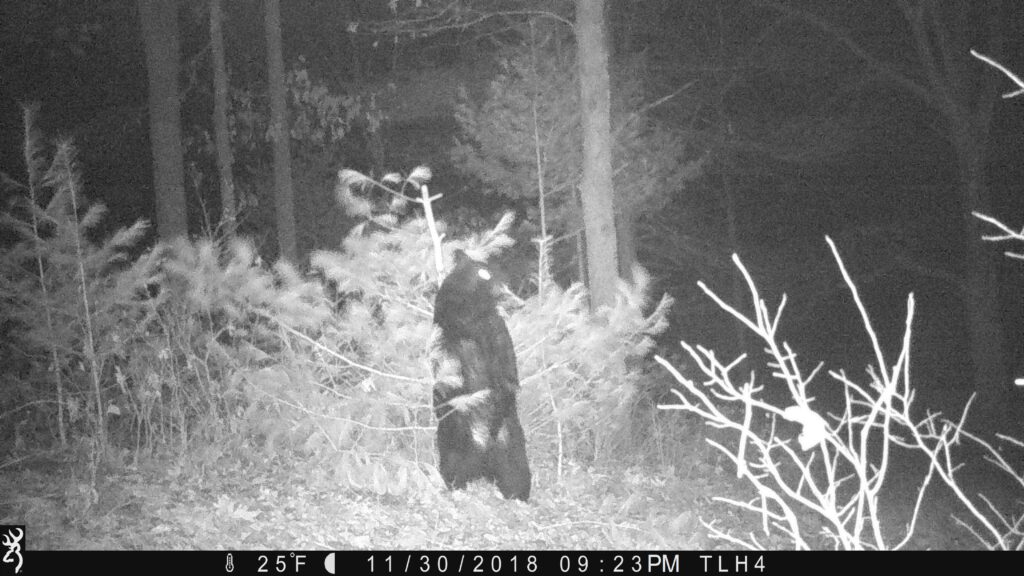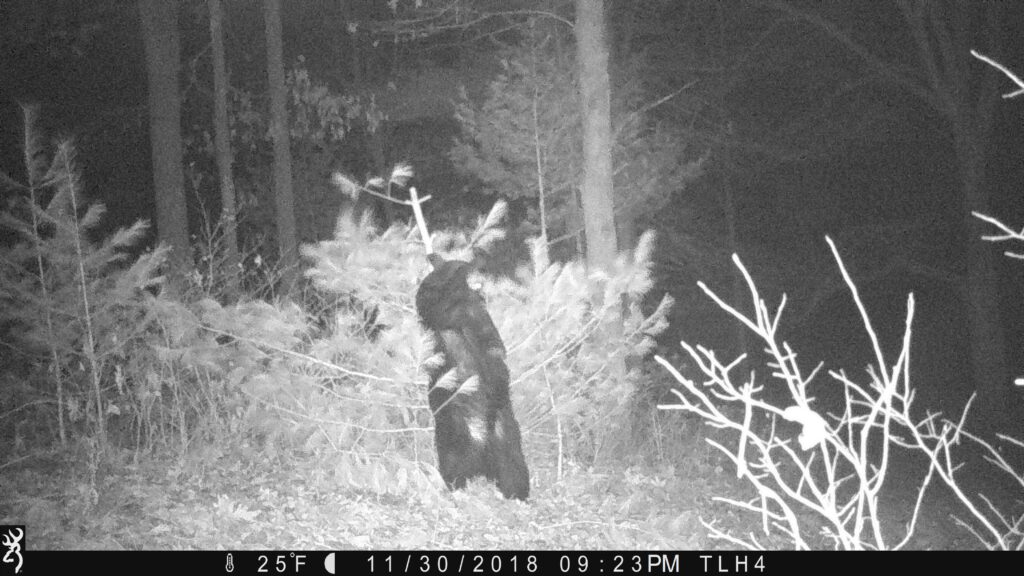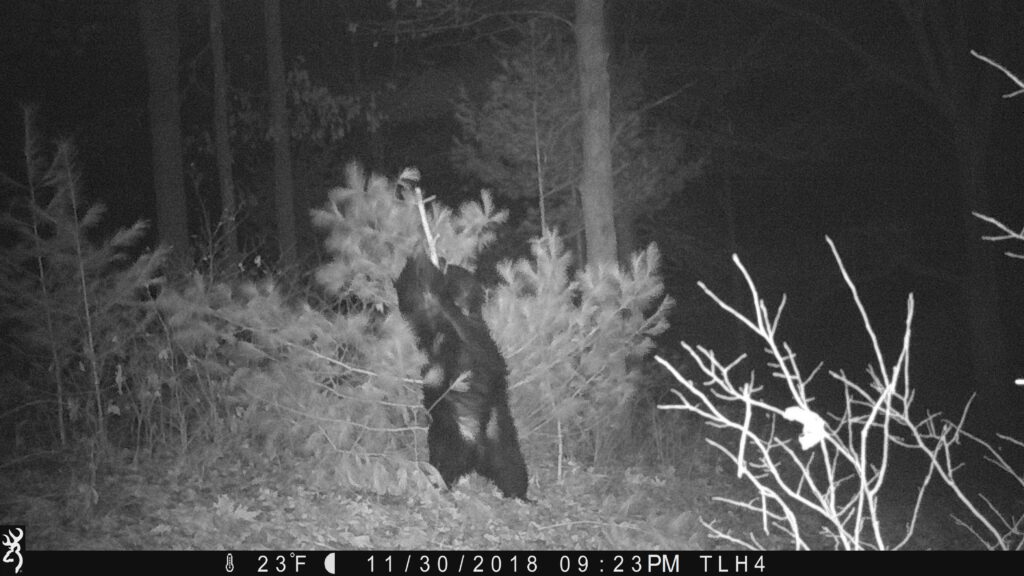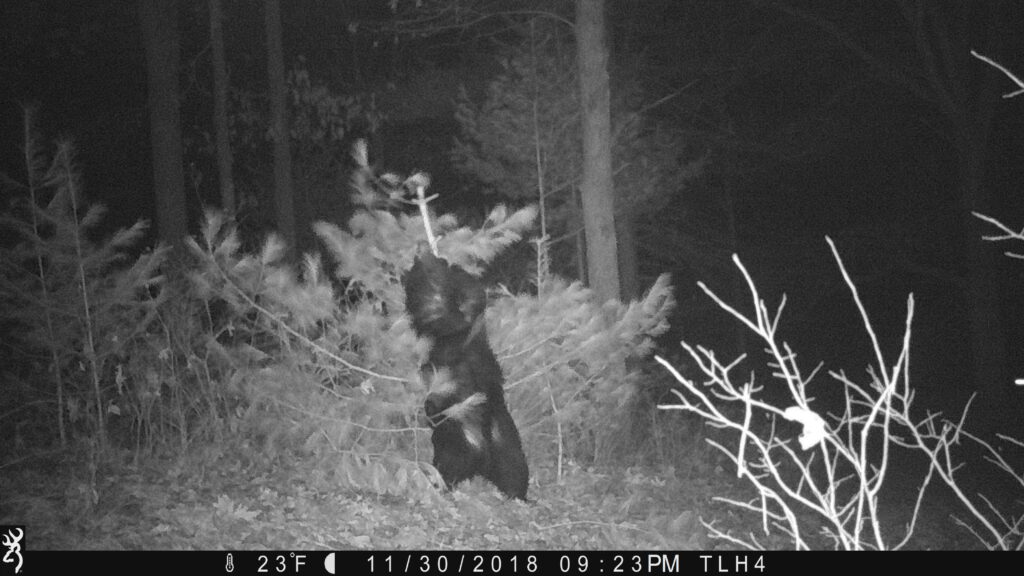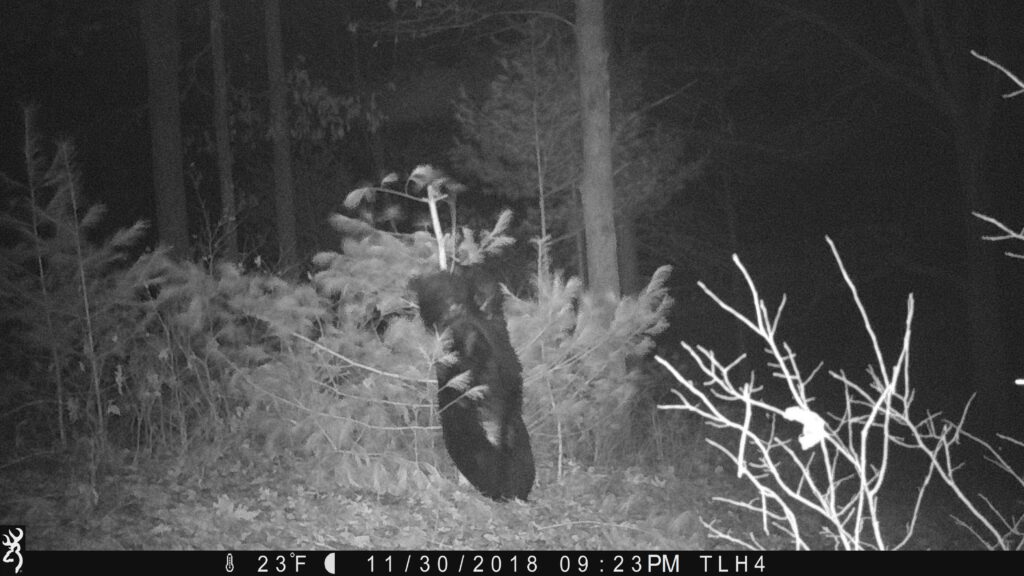Posts Tagged → camp
Yeah, PA’s lame bear season in one picture
Pennsylvania is about to have one of its lowest bear harvests in decades. And like so many policies of any sort, the story of this failure is told not just by the data, but by a picture of the data (see below).
In sum, this year’s early bear seasons of archery and muzzleloader resulted in roughly 1200 bears being taken by hunters. These are predominantly individual hunters in elevated stands, not crews of drivers pushing bears to standers.
By the time the real firearms “bear season” arrives in late November, much of the steam has been bled out of the system, so to speak. The demand has been met. Many serious bear hunters have already taken their bear and they won’t be going “to camp” to participate in punishing bear drives through thick mountain laurel on steep mountains in the northcentral region. And when the most ardent hunters pull out of a camp, that loss of energy and excitement affects everyone else. We noticed many empty camps across the entire northern tier this past week.
Again, the 1,217 bears taken in the early season so far are 200 bears ahead of the roughly 1,000 bears on record for the “bear season” as of tonight, which is the end of the formal “bear season.” In other words, bear season wasn’t. It is actually producing behind the early season.
So is the early season the real bear season now?
Add a poor acorn crop to the situation, and whatever bears were roaming around in October’s early season have gone to den for the winter now in our “bear season,” or have moved southward by the time November arrives, because all of the available wild food has been eaten up. We are now in our third year of a failed acorn crop in the northern tier, and the silence of our woods shows it. No food means no wildlife. Hunters saw no poop, no deer rubs, no squirrels, no nothing. Hunters scouring rugged northern tier landscapes that are the historic high producers of bears are encountering woods devoid not just of bears, but of deer and turkey, as well.
Yesterday was a classic example of this dynamic. Our guys put on a drive across a NW Lycoming County mountaintop area that usually holds bears. I was the lone stander in the primo spot, a saddle between two hills with a stream running through. I could see far in every direction. There were no other drives happening anywhere around our guys, which is unusual. But another and much larger drive was going on behind me, and pushing toward the area we had hunted the day before. And half a mile down the forest road several long range hunters were set up looking across a canyon. If there were bears around, or even deer, the two drives would push them past the long range guys, at least.
And yet, by the time dusk arrived and our men had slid and tumbled down the mountain side to gather at the truck, no one anywhere had seen a bear or a deer, nor heard a shot. The long range guys were packing up as we were driving out, and they told us they had seen several deer on Sunday, but nothing else any other day, including that day that had so much activity.
The Pennsylvania Game Commission is a government agency, and agencies make mistakes. Sometimes the best-intended and carefully considered policies have unintended consequences. Maybe the Saturday opener (as opposed to the long-time Monday opener) to bear season is part of the failure we are seeing. Maybe it’s the acorn crop failure making a bad situation worse. Maybe it’s the early season stealing all of the thunder from the regular rifle bear season. I don’t know the entire answer why, but the numbers don’t lie, and this 2023 bear season was a flop. Yes, we will see another 100-200 bears taken in the extended season that is concurrent with deer season in some Wildlife Management Units. But overall, PA has not seen a bear harvest this low in a long time. And as I recall, last year wasn’t that great, either.
Something is wrong and something needs to change. A lot of small businesses in rural areas depend on these big bear and deer seasons to make their end-of-year financial goals. Let’s hope the PGC staff and the board are up to the task of fixing it.
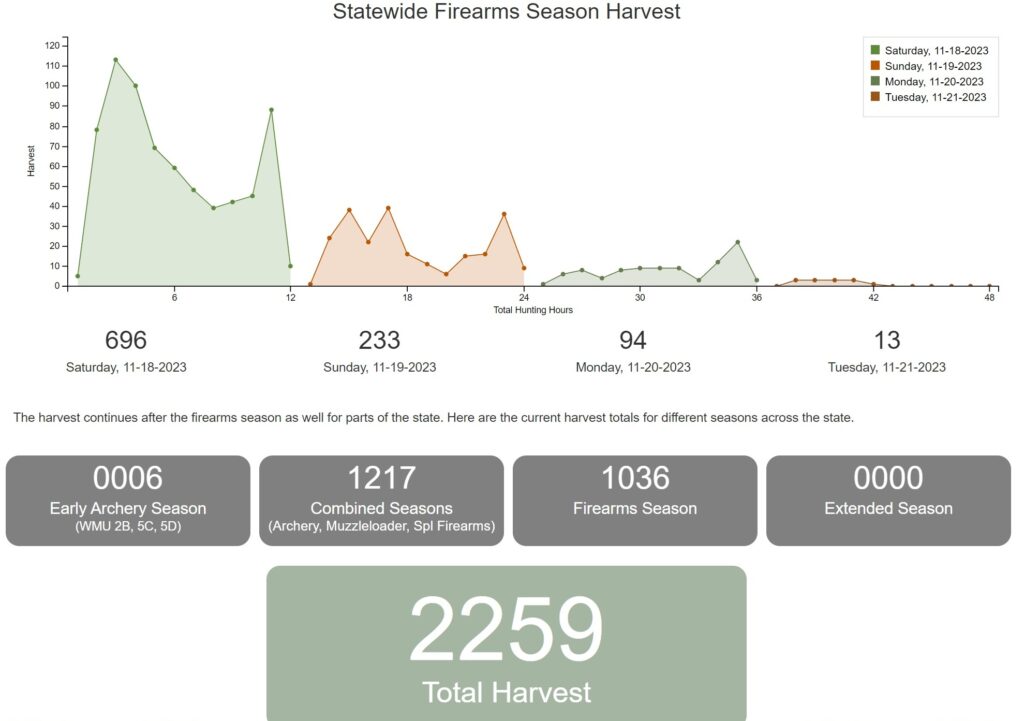
Harvest results as of the last night of regular rifle bear season, 2023. Not final, but not going to change much. The early season was the best season.
A thousand overnight tragedies
Normally, the smell of rotting fish is a signal to clean out the fridge or to leave the area you are in. It’s a universally bad smell, and no one normal wants to be around it. But it was a pervasive good sign where I happened to be standing, because it was associated with the freshly dead salmon heads and remains at my feet that had not been here the previous afternoon. A thousand individual tragedies had occurred along this stream bank overnight, as bears had picked muddy bank spots to grab spawning salmon and take them uphill where they could eat them without the fear of being ambushed by humans, or bigger bears.
We had hunted and fished along a roughly seventy mile vertical stretch of southeastern Alaska for over a week, and in addition to beginning to smell a little fishy myself, I had also saturated and possibly satiated a cavernous need inside me. It is an ever-present deep, clawing need that most wilderness seekers share, be they bikers, hikers, canoers, campers, photographers, fishers or hunters. Sorry, I am not going to quote Thoreau or Muir or Roosevelt on the tonics, joys, highs, or benefits of directly experiencing wilderness. My own wilderness pleasure is gained from simply not seeing a single other human being (except my hunting/fishing partner, when I have one) anywhere near where I am hunting or fishing. That unusual moment results in me feeling like I have better than average odds of achieving my goal, because I have the whole landscape to play without intervention.
On this trip, my “public” goal was a wolf, a blacktail deer, and/or a big black bear better than 300 pounds. Hides and skulls alone were going to come home with me. Edible meat was going directly into my buddy’s freezer. All of the many salmon I caught on the trip went into either my buddy’s smoke house, into his freezer, or into my stomach. It pleases me to report back that chum (dog) salmon directly out of the ocean taste damned good. It is also a fact that chum salmon do not keep well overnight, and that even halibut turn up their noses at it. I suppose freshly caught chum can be immediately canned, but given that there are usually better alternative salmon species to eat and can, I don’t see why a person would make this choice.
Incidentally, about those salmon: Alaska’s management of its salmon runs has been so good, so professional, so scientific, and so successful, that there is actually a glut of salmon in the streams and on the American market. Therefore, wild caught salmon prices are way down. A lot of commercial salmon boats were out netting, and the cannery we visited was in business, but with diesel fuel at about eight bucks a gallon there and salmon at eighty cents a pound, it’s hard to see how the netters will survive. But thanks to the Alaska Department of Fish & Game, the bears have plenty to eat before denning and hibernating for the long, cold Alaskan winter.
Goals are critical on a wilderness trip. Even stupidly simple ones. You have to have goals before you set out on a trip like this, or else you will wonder what the heck you were doing out there when you get back to civilization. My actual personal goal was simple: To fish and to hunt as much as I could, and this goal was easily met. On this trip, I was often able to do both hunting and fishing simultaneously: We slowly trolled salmon spoons behind the boat while glassing the shorelines for critters. A rubber dinghy towed in the backwash provided us the ship-to-shore transportation we needed. See a salmon stream that is calling your name? Go ashore and hunt it, and look for salmon-eating black bears to fill some tags; and look out for the griz. We saw a lot of griz.
Only saw wolf tracks in one very remote spot, and I passed up the one black bear I had a shot at. Only twenty feet across the salmon stream from me, he was either a genetic runt, an ancient-looking yearling, or maybe a female. Whatever kind of black bear he was, he was crabby enough to growl at me before shambling off to less crowded fishing spots. I wouldn’t shoot a bear that small in Pennsylvania, and I sure wasn’t going to fill my Alaska tag with it. Maybe I will go back for the spring bear hunt in 2024.
Despite fighting our way up into the interior of an island known to have blacktail deer, we saw none and feared the griz there more than we were willing to keep going after deer. Signs of griz were everywhere. I picked and popped high bush cranberry and high bush huckleberry while noting the increasing deer browse the farther in and higher I got. But it was a veritable jungle, and surprising a griz up here would mean my certain mauling, possibly my death, and so I decided to nicely frame my deer locking tag when I got home instead of risking life and limb to fill it. I headed back out and found Merlin asleep in the sunshine on the beach.
A loud thud on the bottom of the boat awakened me from my cramped sleeping position, and I rolled out of my sleeping bag onto the cabin floor, which was cluttered with gear and guns. Walking out onto the deck to look for the source of the thump, I saw a sea lion, a seal, and a pod of porpoises chasing salmon all around us in the early morning dimness. Mist rose from the water, and then the rosy tint of dawn’s first sunbeams lit up a nameless glacier high up in the crags across the water. I felt stoned on all this Mother Nature. Like I said, I was there just to hunt and fish, and whether or not I went home with the physically tangible results was not nearly as important as absorbing and sucking up the magic around me and filling that big, hungry, empty cavern in my soul. You just can’t have this magical experience without public lands, and some of that designated as wilderness. This, these, we had.
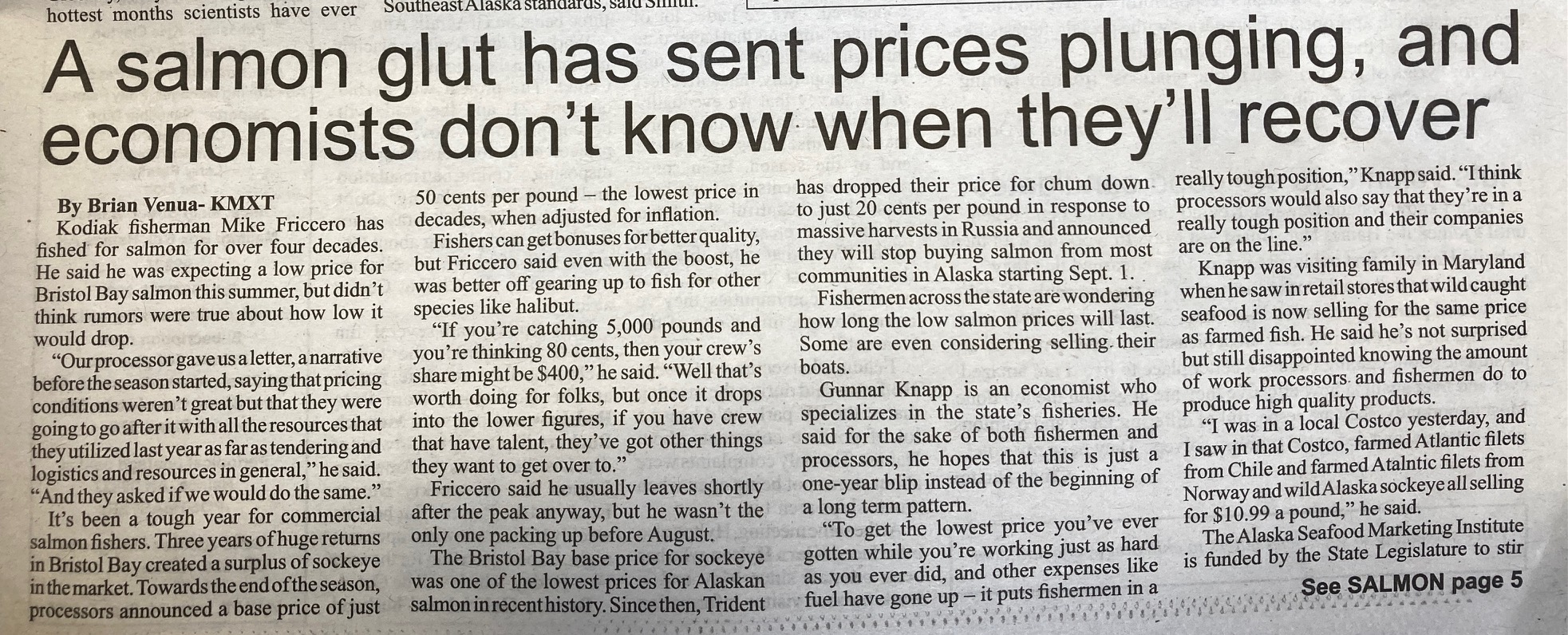
Alaskan salmon management has been so good that there are actually “too many” salmon, if there is such a thing
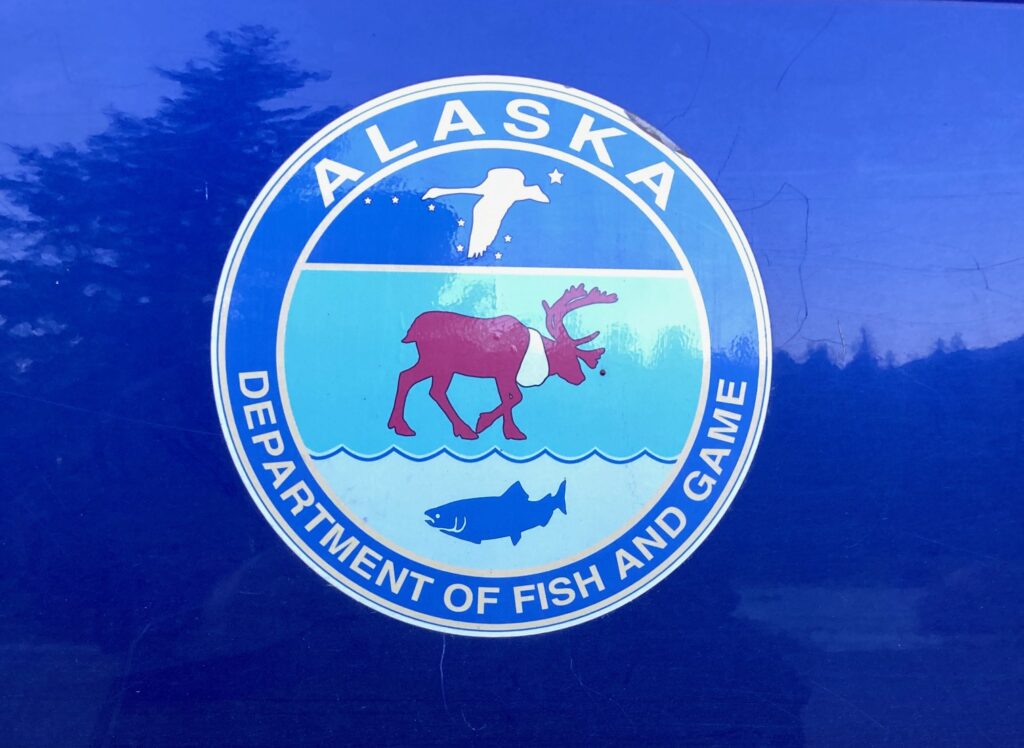
Reflected is the Chilkoot River, where we fished with the bears and a gaggle of international tourists following them up and down the river
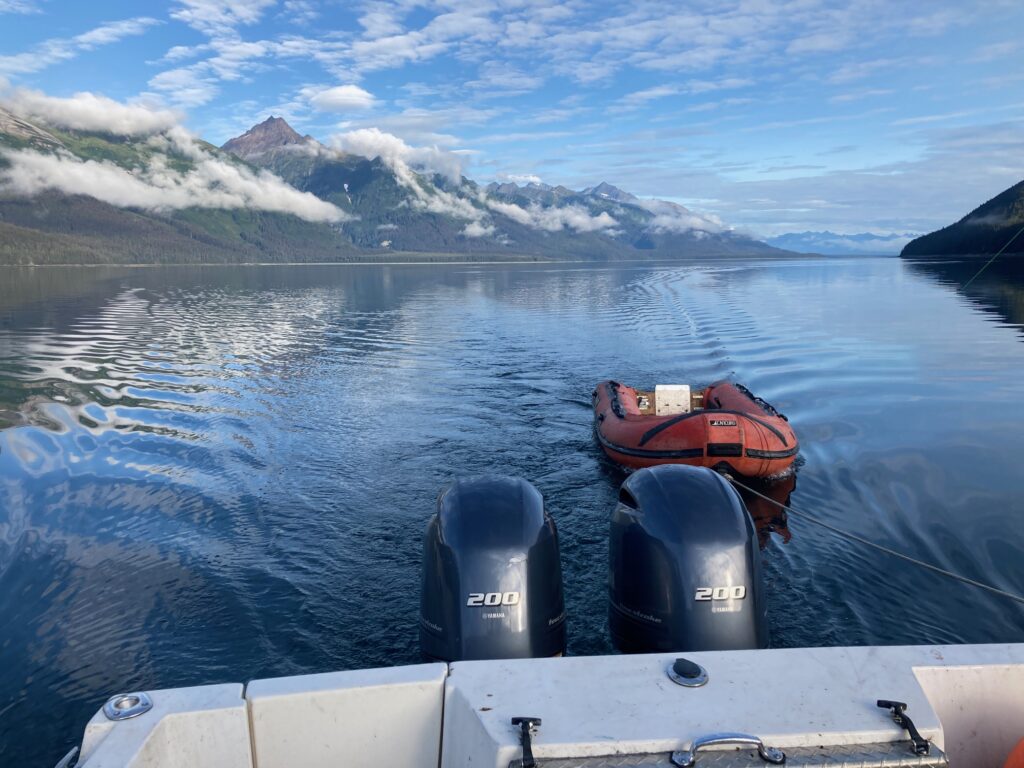
Trolling spoons for salmon, towing our dinghy, and glassing the shoreline for critters. This is hunting and fishing at the same time
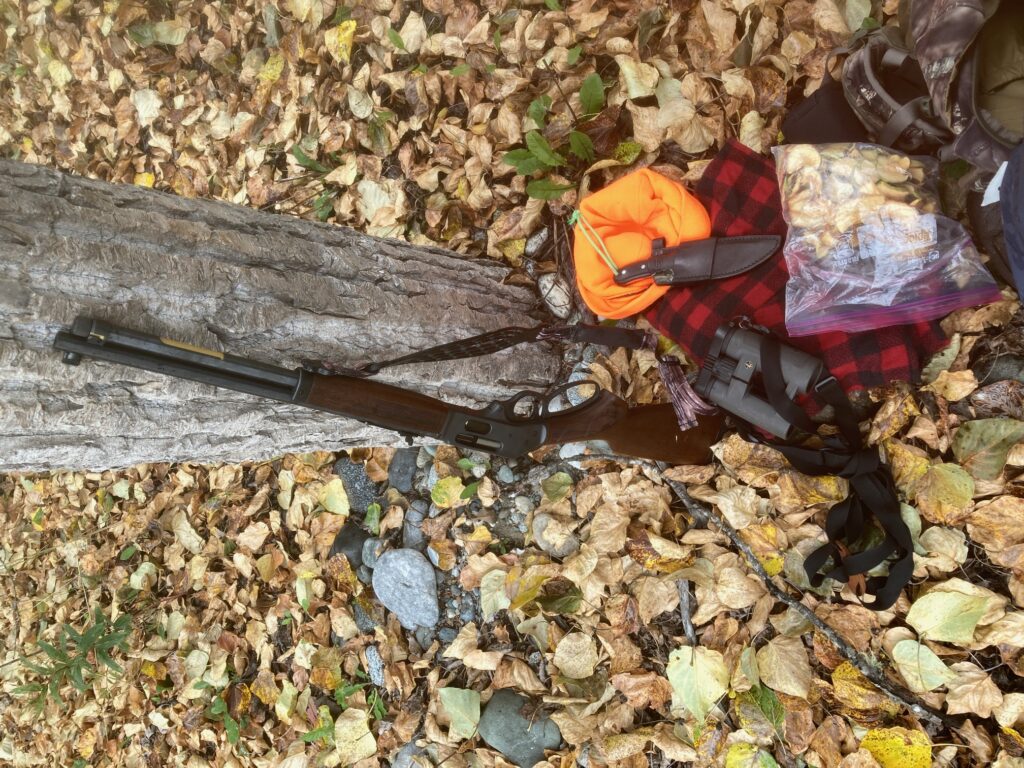
My hunting kit. A Henry 45-70 lever rifle (not crazy about the cheesy rear sight), a JRJ knife, rugged Leupold binoculars, home made dried fruit and jerky
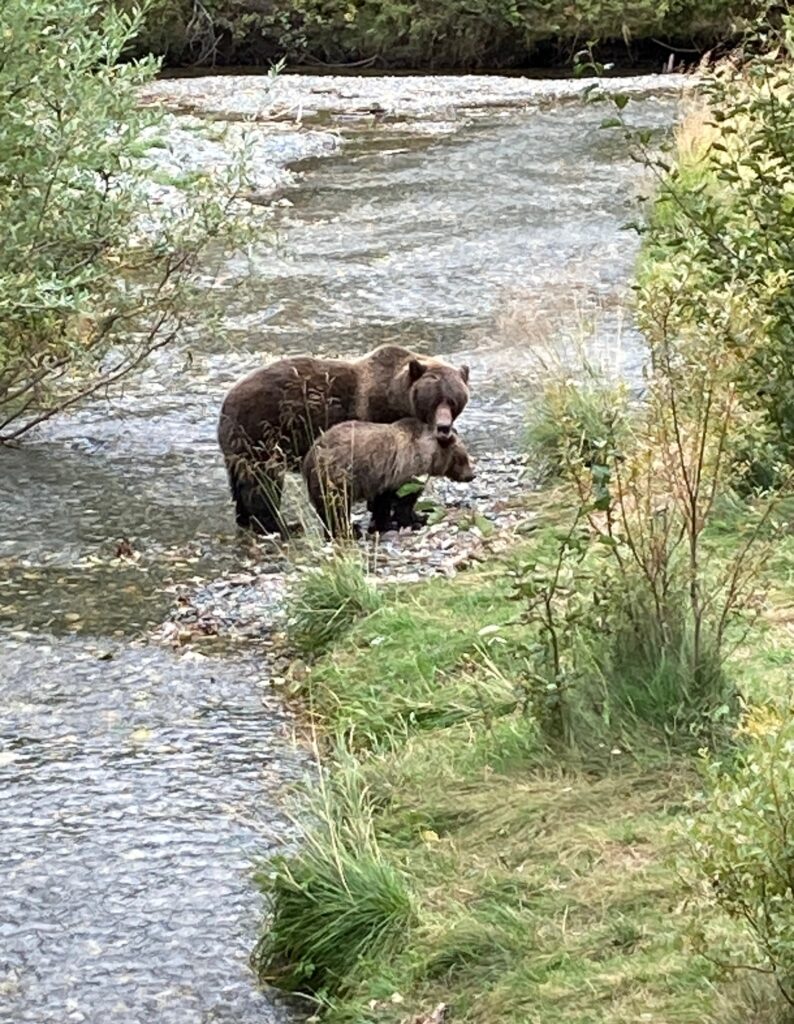
Grizzly sow and cub eating salmon as they spawn upstream from the Chilkat River. I saw a lifetime supply of griz on this trip.
Anatomy of a deer season
It doesn’t matter if you archery hunt for deer religiously, from October 1 to mid-November; the archery season is always over way too fast.
It doesn’t matter if you archery hunt a bit for bear and deer, hunt the week of early muzzleloader for bear and doe, do some small game hunting, have the men up to camp for bear season for four days, and then hunt every day of deer rifle season. The ending is always the same: It ended way too fast. We wait all year for this time, and before you can blink an eye, it is over.
For many hunters, this time is about being afield, hunting. The occasional actual killing part is a welcome indication that the hunting part was done well. Proof that the time spent outside was not wasted.
Oh, we still have some late deer season remaining, which is the late archery and flintlock hunt. But by now, deer everywhere in Pennsylvania are on high alert. A twig falling out of a tree and rustling a leaf on the ground will send a nearby deer herd into panicked stampede into the next county. So getting deeply enough into the sensory zone of these intelligent animals to take one with a bow or a flintlock at this stage takes real skill, not just the usual luck.
Although I will hunt the flintlock deer season, because I have some DMAP tags left, looking back even now with a sense of longing has me thinking about the anatomy of a good deer season. Some take-aways:
- Eat good food. Whether it is home-made jerky and dried fruit we make ourselves for our own time afield, or it is the extra thick gourmet steaks we bring to hunting camp, eat the best quality food you can afford. Hunting alone or with friends and family is a celebration, so eat like you are celebrating. And because Man does not live on bread alone, make sure your drinks are of a commensurate high quality.
- Practice, practice, practice with your gun. Archery hunters practice non-stop, but for some reasons many gun hunters leave it to one box of ammo and the days right before the season to “practice” shooting. Well do I recall sharing a range with a guy from Lancaster County at the bench next to me. Friendly enough, he enthusiastically, if spastically, launched his one box of “extra” shells down range as rapid fire as a bolt action can fire. I had offered him the use of my spotting scope and Caldwell shooting sled, and he declined. He did end up relying on my spotting and calling his hurried shots, however, because he didn’t quite have his scope figured out. The old random “spray n’ pray” is the approach he packed up and drove off to hunting camp with. Do any of us think he hit what he shot at?
- Bring your best jokes, naughty or practical. Hunting camp is fun, and each of us must contribute to that festive atmosphere. Many years ago, I bent down to inspect a strange looking object hiding under the cabin’s kitchen counter. And just as quickly I jumped back and screamed like a little girl when the damned thing took off running. That it was merely a muskrat pelt attached to a fishing line being pulled by Bob and followed by uproarious laughter at my expense just made my revenge all the sweeter. As for naughty jokes and rhymes, the list is endless. Look them up and bring half a dozen. Maybe I am lowbrow, or maybe I have low expectations, but it sure seems that everyone present laughs at these men-only jokes.
- Get out into position early, like at least an hour before first light, and when you move play the wind (nose into the wind), go quietly and slowly, and carry your gun port-arms and not across your back. If you can get out into position at 4:30am, even better. Just bring a blanket and some Zippo hand warmers.
- Food sources matter for deer and bear, too. We humans are not the only ones who both enjoy and need food. In a year of abundant acorns, a stand of sweet tasting white oaks will draw more deer and bear, and you can sit down wind of that stand of trees. In a year of scarce acorns, like this year, any tree that had a decent crop will still draw animals pawing in the leaves for whatever may be left in early December. By this mid-November, almost all of the already scarce acorns were eaten up, and both bear and deer seemed to be moving widely across the landscape in search of any food. It makes for tough hunting, and so we have to team up with buddies and other camps to work together to scoop up what animals are out there. Be flexible and think outside the box of a permanent stand.
- Speak animal language. Last year I grunted in an Adirondacks wilderness buck after busting him out of his bed. He was a territorial and aggressive SOB. But the conditions were all wrong for playing around, and although his body was visible, I could not shoot through the beech brush to get him. This year I returned for Round Two with the same animal, which had probably never seen a human being, and after two days of tentative efforts, Day Three resulted in the furious huge buck storming right in to my position with leaves, twigs, snot and mouth foam flying. I shot him in the neck at five yards, five miles from my truck. Lot of work, totally worth it for that DIY hunt of a lifetime. My position was carefully chosen for what he could see or smell under a certain wind direction. I waited until it was all just right, and let fly. His response was immediate.
- Take pictures, send them in emails. While journaling is not dead, most people today do not write in a personal or camp journal. Instead, we take photos and email them around. The recipients always appreciate them. Especially when ten or twenty years has suddenly passed, our knees don’t seem capable of all those steep climbs and hard sidehilling drives any longer, and a lot of our best times at hunting camp are sitting around with dear friends and reminiscing together. So don’t forget to take pictures and share them.
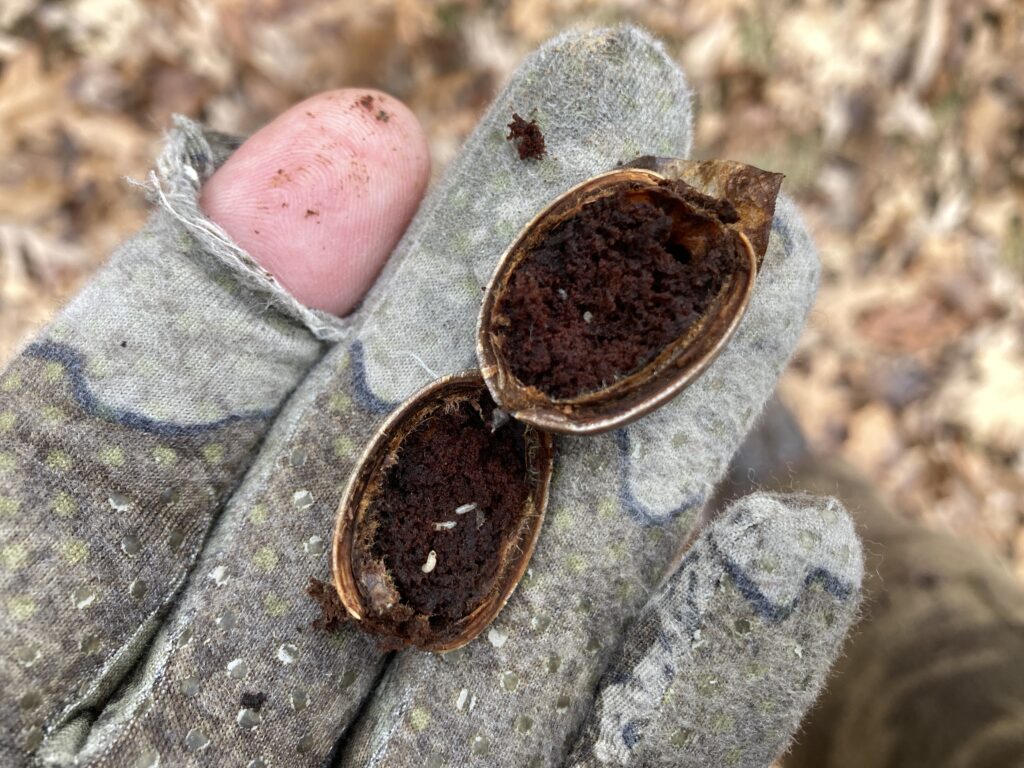
Northern PA’s acorn crop largely failed in 2021, possibly due to a late frost that killed the acorn flowers. Acorns remaining on the ground looked OK from the outside, but were all rotten like this on the inside. Wildlife is hungry and moving widely to locate food.
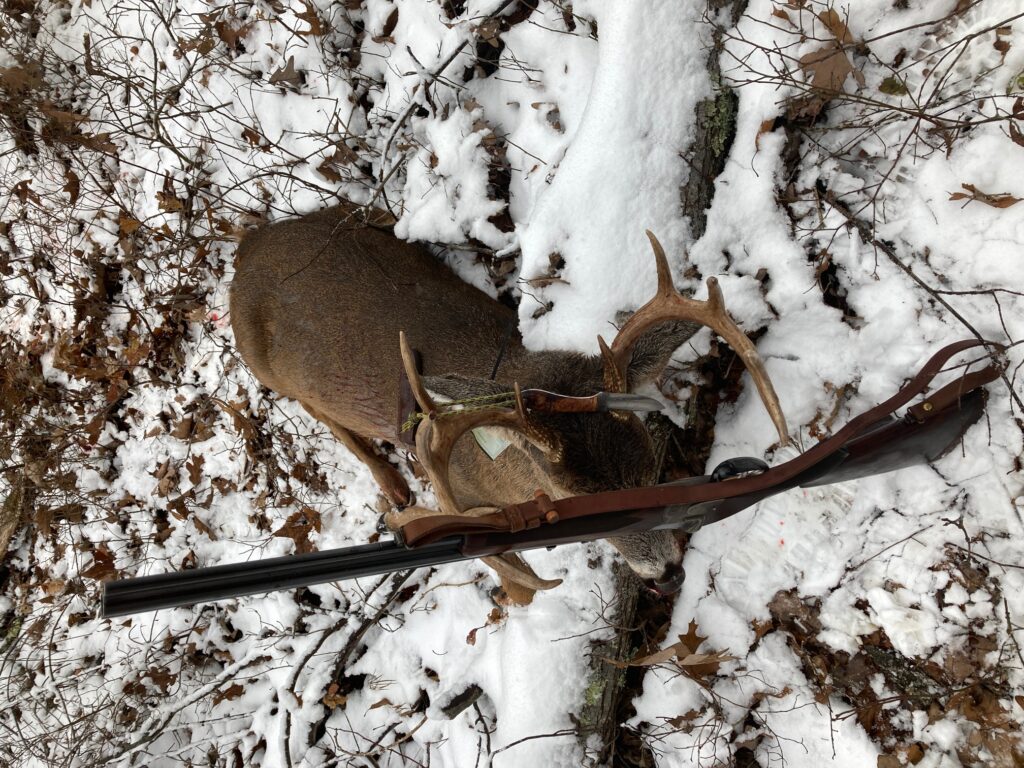
My “Freedom Buck,” killed on Sunday November 28th at 7:45am, on private property in PA. The ban on Sunday hunting is an attack on freedom, and so I named this Sunday morning buck after my declaration of freedom.
Reflections on 2020 bear season
As if by magic or just the batting of an eyelid, the much anticipated 2020 bear season is now behind us, having concluded at dark yesterday. Sad to see our friends go; we had such a fun time! The last of our bear hunting guests have left, cleanup has commenced, preparations are under way for Thanksgiving, and there are some reflections to be had on bear season.
First, where the hell were the bears? Serious question here. We hunt in a mountainous Northcentral area that is Pennsylvania’s “Bear Central.” And despite us daily scouring a lot of remote, very rugged territory that is usually home to lots of bears, we saw neither bears nor bear poop. None. It could be the warm weather has bears hunkered down under cool overhangs in even more remote places. It could be the low acorn crop has bears going in to hibernation early, because there is no more food for them to eat to put on the extra fat they need to hibernate successfully. The truth is, no bear tracks or poops have been seen around here for months, which is remarkable. I cannot think of any year prior like this.
Second, where were all the hunters? We heard only a few shots between Saturday and Sunday, and either none or one on Monday, and for sure none on Tuesday; and very few hunting parties were on the radio on any day. This means that few large scale hunting drives were going on. Without hunters moving across the landscape, the bears don’t have to move out of their way. They can just sit still and not run the risk of exposing their rib cage to a hunter’s bullet. That means that the bears can loaf about in some remote corner, escaping the unseasonable warmth or just waiting for the wafting human scent to drift away before making their usual rounds again. Which means the few hunters who are out don’t see much action.
Third, where were all the other critters, like turkeys and deer? Like with bears, we saw very little deer or turkey poop in the woods. And although I myself saw two whopper bucks and a five-point up close, no one else saw any deer. Nor did any of us see any turkeys. Once again, the absence of these otherwise ubiquitous animals could be due to the relative absence of acorns. Which would push the wildlife far afield to find food sources.
Fourth, despite all of our hunting setbacks, did any of us care a bit? No! We missed all of our friends who could not be with us for various reasons, like fear of the CCP virus, or family emergencies requiring them to stay at home. But those of us who gathered had a lot of fun nonetheless. And with or without a bear on the game pole, we would not have missed this time together for any reason at all. We caught up on our families, our work, our homes, cars, friendships, wives, and politics (yeah, there was a lot of pro-Trump politics). Some people drank way too much alcohol, and we got some great pictures of it all, like the one guy asleep on the cold ground outside. No, we don’t post those here. We ate like kings, that is for sure, and no one lacked for food or drink.
Finally, it is possible that the new early bears seasons (archery, muzzleloader, and special junior+ senior rifle) are removing so many bears from the woods that come rifle season, very few huntable bears remain to be had. According to real-time hunting harvest data posted at the PA Game Commission website, more bears were killed in the early seasons than in the official rifle season this year. This means there are fewer bears available for the rifle hunters. It is possible that many hunters expected this, based on last year’s harvest patterns, and they stayed home or hunted alone, instead of joining the big crew at camp, like usual. As of late today, just 3,138 bears had been killed total this year. That is about a thousand fewer than expected.
Based on this raw data alone, the early bear seasons are actually backfiring. They are not removing the high surplus number of bears that are beyond Pennsylvania’s social carrying capacity. Rather, the early bear seasons are removing the easiest bears and leaving few to be hunted in the later rifle season.
And this new dynamic could be the real story in PA’s bear season: There are so many early season bear hunting opportunities for individuals that they collectively take the wind out of the sails for the regular season hunters, thereby having a boomerang effect on the entire thing and limiting it.
We won’t know what all this data really means for another few years, and by then either great or even fatal damage will have been done to Pennsylvania’s traditional bear camp culture, with its big gatherings and big drives and big camp camaraderie dying out, or we will simply all have to learn to adapt to new ways of hunting. I have to say, there is no substitute for men gathering at a camp to hunt together. The gathered hunting party is the most human of experiences; it is an institution as old as our species. Its purpose was not just making meat, but also social and sociological.
I sure hope these myriad new early bear seasons are not self-defeating, in that they do not kill that traditional bear camp culture by removing its whole purpose ahead of the game. Question for the PGC: What incentive is there to push your body hard through rugged and remote landscapes, destroying your boots, tearing your clothing, and often losing or breaking some of your gear, including damaging your gun, when the animal you are seeking has already been removed?
Below are some photos from one of our trail cameras two years ago. Just days after bear season ended, a bear was caught gloriously and most joyously rubbing its back against a young white pine tree. Almost like a pole dancer. Pretty hot hip shakes there. We haven’t seen a bear anywhere around here since May this year.
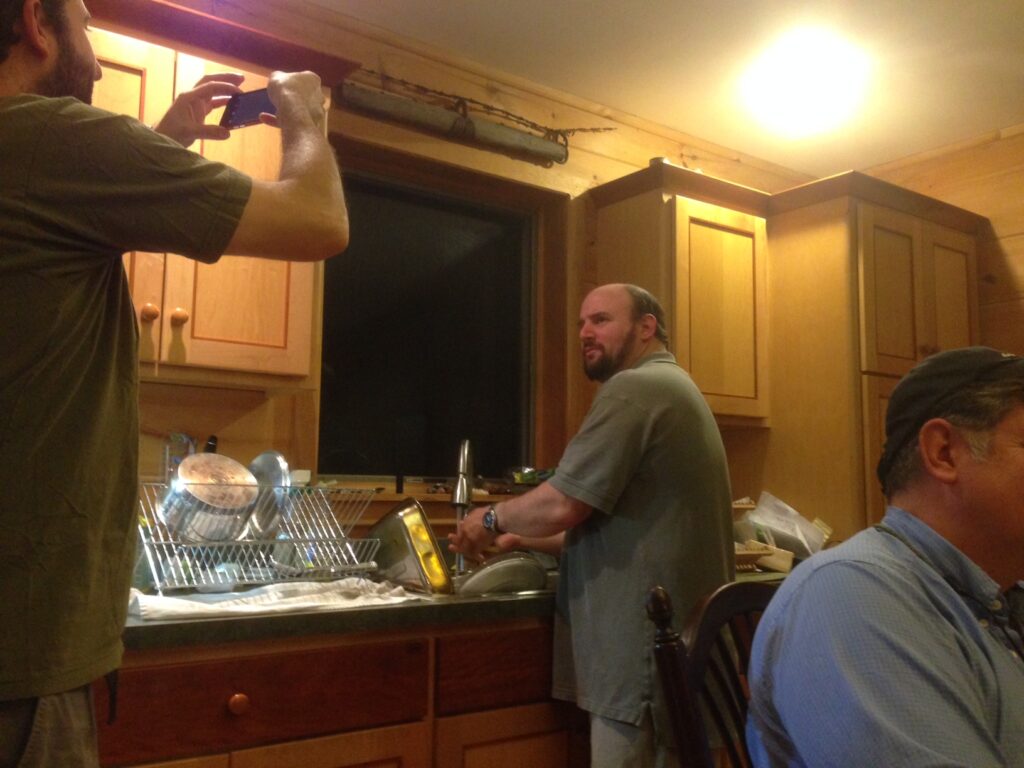
When one of our guys is finally browbeaten into washing dishes after years, it is cause for “Notify the media” acts like taking his unhappy picture. This is back in 2015. He still has to be browbeaten into washing the damned dishes

Lycoming County is the boot-looking shape in the northcentral area. Its northwestern corner is where we hunt. The darkest township there demonstrates the importance of organized hunting drives. A bunch of large hunting clubs are located in this area, and their members put on highly coordinated, obviously successful drives.
Does your kid have autism, ADD, ADHD? Nope. Modern society is what’s off, not your kid
For about 70,000 years (or 5,780 years for literal Bible believers) our species Homo Sapiens Sapiens has been on Planet Earth. In that time we have proven ourselves to be not only the dominant life form capable of killing everything else, but so good at killing that we are capable of killing ourselves, as well.
Over this long period of time, humans evolved as hunter-gatherers. We spent all our time hunting and gathering food, and we spent most of our time sitting around a camp fire eating meat we had hunted and fruits and herbs we had gathered. It is a lifestyle perfected by the American Indians and known to us today because we largely ended it through mass migration into their pristine Eden.
During the European conquering of America, very few Indians became European, most resisted to the death. The few who willingly adopted European clothing and religion can almost be counted on two hands. Indian schools like the one in Carlisle were renowned for runaways and coercive methods to convince little Indian children to adopt European ways.
On the other hand, many, many, really countless numbers of European Americans “went native.” They willingly sought out and joined with Indian tribes across the continent, wore their tribes’ clothing, spoke their language, adopted their habits and customs. This happened because something innately natural about the hunter-gatherer lifestyle powerfully speaks to the hunter-gatherer that is inside every human.
Even when it is covered by the thin veneer of “civilization” like today.
This is why people today still hunt, camp, hike, fish, seek wilderness etc. Our species evolved in these natural environments doing these exact activities, and these are the activities that are most natural to us humans today.
Look at it mathematically: For 65,000 of our 70,000 years on Planet Earth we humans were only hunters and gatherers; subsequently for 4,500 years we learned to farm and grow our food; then for 150 years following we became industrialized; for 125 years after that we have been eating out of a tin can and driving motorized vehicles; then for 100 years we have lived in the Information Age. Only in the past few decades have we lived as we currently do, in a massive consumer society driven by high sedentary living and complete materialism.
So 30 years divided by 70,000 years equals only 0.00042857% of human time on Planet Earth spent as we live today. This is to point out that our technology-heavy western lifestyle today, which we take for granted, is in fact not even a blip on the radar screen of human existence on the planet.
Which is to say, the hunter-gatherer lifestyle is most natural to us, it is hard-wired into us, and the iPhone-heavy digital lifestyle is totally new to our species. Our current lifestyle has a lot of costs that we do not yet understand, and yet we have embraced it in a death grip.
So when your beautiful child is “diagnosed” with autism, ADD, ADHD, etc., be skeptical. It is unlikely that there is anything actually wrong with your kid. What has happened is that our modern industrial, sedentary, virtual, digitized society has developed new standards for living and behavior, and for measuring success, that are completely at odds with how we evolved, how we are hard-wired, how we have lived most of our time on this globe, and how we need to be in order to be our most natural, most happy, most successful.
In a hunter-gatherer society, those young people who notice movement the quickest are not easily distracted. Rather, they are going to be the most successful hunters and warriors on a landscape where movement equals either food or danger, and those who see movement the fastest either live the longest or eat the most food. In that hunter gatherer environment, what we today call ADD is actually an important adaptive skill needed to survive.
So an “autistic” kid today who is obviously bright and technically gifted but socially quirky, was, five thousand years ago, probably the best flint knapping spear head maker in the tribe.
It is today’s Western society that is living at odds with our most human traits, long adapted and refined over tens of thousands of years, and only now considered to be liabilities in a physically weak, feminized, pacific, diabetes-riven technologically-based culture where food is served up by the unhealthy bucket-full with no effort required by the eater.
Got an autistic kid? Put him or her into a more natural setting, away from dominant society where they are mis-judged by unhealthy, unnatural material and behavioral standards, and watch them flourish. Even better, withdraw from it yourself!
Friends in low places
Several years ago several ambitious construction projects were begun, where the building material would come from our own oak trees on our property. Oak may not be the best or easiest building wood, because when it dries it is heavy and as hard as iron, and thus tough on tools and shoulders alike, but it is what we have there.
So oaks were cut, skidded, piled, and then milled in situ over about a five year period. An injury and subsequent surgery prevented me from continuing this remote effort, which then moved forward in fits and starts over several years. When we finally got around to completing the actual projects, much of that beautiful oak had been sitting out for a long time, and in some cases too long. After using up much of that oak lumber, a large amount yet remained in piles, where it had air dried.
Last week was my final drive to get under roof thousands of board feet of two-inch-thick oak boards, heavy beams, and smaller posts, before they started to rot. It was a lot of work. The unusual heat and blazing sun made the work go slower. One thing that surprised me was the absence of mice living in these outdoor piles. Normally mice run and scurry as the wood is moved, having nested among the boards in perfect little hidey holes.
The last pile of drying lumber was finally put away, with just a few boards remaining at the very end, butted up against a huge boulder that makes up part of a stone wall around the yard. As I dismounted the tractor, stepped over to the board ends, and reached down to grab them, a sound caught my attention.
It was a sound that set off primitive alarm bells in my brain.
At first it sounded like a cricket, and then a grasshopper, and then a second later my mind concluded it was a timber rattlesnake. After stepping back, well, let’s say it was an inelegant, well, ugly (it’s a big fat man jumping, after all) leap, minus my usual little girl scream that seems to accompany most of my unplanned and close-up rattlesnake encounters, I looked down.
A long black snake with a yellow diamond pattern was stretched out next to the boulder, about six inches from where my boot heel had settled moments before. The long grass against the boulder had concealed the snake from my eyes, which, frankly, had not looked there, but had rather been focused on the heavy boards, and how I was going to pick them up and manhandle them to their destination across the yard.
The snake’s angular head and erect tail with rattles confirmed it as a timber rattlesnake.
While it was not a huge male rattler, the likes of which I have caught and moved to safety off of roads and trails a number of times since I was a kid, it was nonetheless big enough to permanently remove a chunk of leg muscle. So I admired it for a minute, and then went on to other work elsewhere. When I returned an hour later, it was gone, though I thought I could see it coiled up right under the boulder’s edge. Instead of reaching down with my hands, I used the pallet forks on the tractor to pull out those last boards.
Over the course of the next two days, my mind kept replaying the encounter. In July 2001, when we had owned the property for seven months, DCNR forester Jim Hyland and I had scoured our property, as well as the adjoining State Forest and part of the adjoining private land, looking for rattlesnakes. That day we found a corn snake, a garter snake, a ring neck snake, and two green snakes. No sign of rattlesnakes among the rock and old slate quarries up high. Not even a shed skin.
So for sixteen years we had enjoyed our property without being mindful of rattlers. Our children had been born and raised around the cabin, running freely around the property. Sure, I spent a lot of time in our woods, a certified Tree Farm, and I have always been on the lookout for rattlesnakes, as well as other snakes, but I had seen few snakes at all, and never a rattler.
Snakes are awesome, they are awesomely cool creatures. I bear them no animosity whatsoever. In high school and college a pet boa constrictor kept me company, until she had grown so large that she was regularly breaking out of her cage and hunting our house cats. When I last saw her, she filled up one side of the man’s living room, and he regularly fed her rabbits and squirrels he trapped in his yard. She weighed about 150 pounds then, and was ten years old. I hugged her, but she just laid there, limp and dozing. Snakes…what can you do? Love em the best ya can.
And so now I am confronted with the fact that a potentially dangerous animal shares our camp with us. All around us we have seen rattlesnakes over the years, mostly run over by cars down on the highway, and increasingly I see them all over central and Northcentral Pennsylvania while cruising timber and looking at land. At some point I did expect them to join us as tenants of one sort at the cabin. Under the front porch is where I thought they would first show up, because it’s good cover and the mice like it there. Struggling emotionally to adjust to this new arrangement has not been painful, but it has been harder than I thought it would be.
The absence of mice under the wood piles reminded me why I accept and even welcome the presence of timber rattlesnakes, intellectually if not emotionally. Mice are a major pest, and they are destructive little bastards. Hearing them chirp and run inside the walls of the cabin at night, right next to my bed, is a source of aggravation. When they eat porch and barn furniture for nesting material, it is infuriating. They pee everywhere, and it stinks. We regularly trap them around the buildings and poison them inside the barn. Help reducing their numbers is most welcome, and anyone or anything that helps achieve that goal is a friend of mine.
Timber rattlers are beautiful to look at, and they are normally pretty docile, requiring a lot of pestering and rough handling to elicit a strike. But like all wild animals they are unpredictable, and the risk they pose to little kids playing outside is significant. Fortunately, our kids have reached ages where they can think carefully for themselves, consciously avoiding areas where rattlers would naturally congregate. And we now infrequently host families with little kids as guests, as most of our friends have kids the same ages as our own children, able to take guidance, if they are with their parents at all.
So the risks versus the benefits works out in our favor. The benefits of rattlers sharing our property are high, because they eat the hell out of mice. Rattlesnakes are my new friends, in low places, where they are needed most.
Welcome, friends.
Central PA is a fantastic place to live, work, play
Today the Dauphin County Planning Commission held its second annual awards ceremony for outstanding development projects around the county.
Held at the historic Fort Hunter barn, and funded in large part by engineering firm HRG and other private donors, the spartan but hard-hitting event showcased how advanced central PA really is, and why it is that way.
At one point in my life, I lived in the Washington DC area. Few people there actually liked living there, and the few pockets of satisfied residents were limited to historic areas with parkland and small downtowns with attractive antique homes. Northern Virginia and some of the old, well-planned communities along the major roads into Washington come to mind. I myself hated the heck out of the area, because its dominant feature was suburban sprawl, a sterile hybrid of city and country.
Happy was the day when I returned to my beloved Central Pennsylvania, and for many good reasons: Little to no real traffic, nice people, beautiful landscapes, lots of protected open space to hunt, fish, camp and hike in, low-cost housing and low cost-of-living, and many other amenities.
At today’s award ceremony, the audience was reminded again and again by speakers just how great a place this area is to live in, raise a family, work, and play, as in camp, canoe, hunt, fish, picnic, hike, etc. That is true. Having traveled extensively, my heart and mind always return to central PA. It’s a great place to live.
On that note, a personal note to new Harrisburg Mayor Eric Papenfuse: Good luck. Our city has been in trouble. Signs are everywhere that a lot of hard work lies ahead to get it out of the rut it is stuck in. But early signs of Papenfuse’s administration are positive; not so much statements, but actions, like hiring competent staff to serve the citizens.
Harrisburg is PA’s capital city and the regional hub. Ten years ago, everyone wanted to move into the city. I hope that the awards handed out today for hard work, exciting vision, and high standards are an indication of Harrisburg’s new-found success.
Ode to bear camp
Not too long ago, just a few years, actually, a couple hundred thousand Pennsylvania hunters would gather together for the three days before Thanksgiving.
They’d meet under old tar paper shacks, new half-round log cabins, and “camps” both fancier and more rustic. Wherever they gathered was “bear camp,” the place from which they would sally forth in the state’s most rugged topography in search of a lifetime trophy, one of Pennsylvania’s big black bears.
This 100-year tradition that spawned many long Thanksgiving holidays and peaceful family gatherings among the quiet outer fringes of civilization was inadvertently destroyed by the introduction of a Saturday opener for bear hunting.
Now, pressed for time, bear hunters can get out on one day and say they tried. Lacking Sunday hunting for bears, these hunters might hang out, cut some firewood, and then return home to watch a football game Sunday evening. Fewer hunters make camp together for the remaining Monday through Wednesday season. Sure, hunters are out there, and some camps have tagged incredible numbers of bears in recent years, but the momentum of camp itself is gone, fragmented by the introduction of Saturday hunting and the absence of Sunday hunting.
To say that bear camp was a unique amalgamation of individuals is a gross understatement. Used to be that only the crazy die hard bear hunters would be so driven as to take off of work. Now, so many guys come and go on Saturday that the flavor and chemistry of bear camp is changed, and for the poorer.
I’m an advocate for Sunday hunting. Lots of reasons why, but the loss of that bear camp feeling is a good one by itself. If bear season opened Saturday and continued through Sunday, the old experience would be resurrected. I miss it, because I miss the guys who come up now to only hunt Saturday, and by the time I arrive Sunday, they’re packing up or already gone. Gone are the easy times catching up about our kids, families, and work.
Now, bear camp has evolved two “shifts,” the Saturday hunters, and the oddball crew made of guys who can think of no better way to spend time than out in steep, remote areas, hanging off cliffs, falling down steep ravines, and sitting around with buddies back at camp at night to laugh about it. Two shifts, same camp. Same roof, different people.
Sad. I want that old feeling back. Gimme Sunday hunting for bears, please, so I can reconnect with the old friends I hunted bears with for over a decade before the advent of a Saturday opener.
UPDATE: Well, plenty of people have weighed in on this essay. Seems that Saturday has opened up bear hunting to more kids than ever before, and more hunters in general. Concentrating most of the hunters on one day is a fact of lacking Sunday hunting. And no one disagreed that the momentum has now been lost on the week days.
Last day of summer…so sad
It is tough to know who enjoys summer time more, me or my kids. Every summer we emphasize time together camping, on day trips to historic sites, beach trips and saltwater fishing, and both day camp and sleepover camp. We spend lots of time together, and by the end of each summer I feel like a big kid.
I admit that it’s hard to say goodbye. But it’s necessary.
Northcentral PA: More Bears than Deer
Although our gang got no bears today, many camps around us did. Just one camp, Camp Orlando got five …five! That’s like deer season, except it’s actually bears. I think bear season is the new deer season in Northcentral Pennsylvania.

